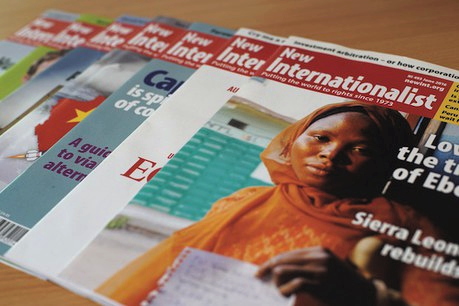Building a progressive U.S. politics means looking beyond the back-and-forth swings of each election cycle.
Published in the November 2010 issue of the New Internationalist.
It is midterm election season in the United States, and in this November’s contests the Republicans will prevail. No one knows whether these conservatives will win handily enough to take control of either house of the U.S. Congress. Nevertheless, it is clear that President Obama and his Democratic partisans, who just two years ago were optimistically touting “Change we can believe in,” are now facing changes they’d no doubt prefer were imaginary.
This outcome has been predictable for some time. Since the 1930s, the party in control of the White House has almost always lost seats in U.S. midterms. Yet such facts are unlikely to calm our high-octane political commentators, who like to imbue any shifts in power in Washington, DC with epic significance. When George W. Bush’s party gained control of both houses of Congress in the early 2000s, conservative strategists such as Karl Rove schemed about the possibility of a “permanent Republican majority.” Likewise, after President Obama swept to power in 2008, former Bill Clinton advisor James Carville predicted “40 more years” of Democratic dominance.
Some people take comfort in the back-and-forth sway of the political pendulum. It is part of the greatness of our “two-party system,” they contend; it reflects the American aversion to extremism on “either side.” For the mainstream media, charting the swing of the pendulum is the essence of the 24-hour news cycle. Each degree of its arc provokes excited headlines, and newscasters await with simmering glee the times when its momentum will stall and the direction of its swing reverse.
The problem is that focusing your attention on the to-and-fro of electoral politics, like staring at the hypnotist’s medallion, can lull you into a trance.
Once in that state, it is easy to miss those political trends that transcend the episodic drama of U.S. elections. A graph of those trends would not show undulating curves that rise and fall based on shifts in Congress. It would be marked by arrows pointing steadily upwards.
In recent decades, raising the budget for U.S. military spending has been a bipartisan passion. That budget now amounts to around $680 billion per year, or considerably more if you think that “defense” costs should include currently left-out expenses such as benefits for veterans of past wars and maintenance of that amiable stockpile known as our country’s nuclear arsenal. Yet even the official tally is more than seven times the military spending of America’s nearest rival, China, and serves to sustain a network of more than 700 bases scattered globally across some 130 countries.
Damage to the environment has similarly accumulated over time. One administration’s mess merely augments that of the last.
Economic inequality is another arrow, and perhaps the most distressing one. Since the 1970s, those in the top percentiles of U.S. society have claimed a greater and greater share of the nation’s wealth and income. The once-garish sight of a CEO making more than 250 times the pay of an average worker is now the norm. This, combined with the steady growth of corporate power, has given the wealthy a firm hold on the levers of our democratic politics. A landmark Supreme Court decision in January, which eliminated restrictions on corporate spending in U.S. elections, only strengthened their grasp.
The power of organized money is everywhere evident. Much-hyped movements like the Tea Party cannot be entirely regarded as artificially groomed “astroturf.” The right has tapped into a genuine reserve of popular anger about the economy and the political system—channeling this discontent to support a politics that decries “big government,” supports tax cuts for the rich, and lashes out against new immigrants.
At the same time, it hardly hurts these movements to have billionaire magnates—such as the oil and chemical titans Charles and David Koch—who are willing to spend untold millions on organizations to sponsor their rallies, candidates to champion their causes, think tanks to furnish them talking points, and journalistic outlets (if Fox News can be called that) to hang on their every half-cooked slogan.
Given the influence wealth affords, it is a testament to democratic determination that resistance still arises as often and as undaunted as it does.
In the past decade we have seen uprisings in the U.S. against corporate power that have united labor and environmental movements, protests for immigrant rights that have often dwarfed their nativist counterparts, and a growing awareness about global climate change and the need to take action against its causes. The grassroots activity that surrounded Obama’s candidacy—which was centered on but not contained by his official campaign—shined light on a broad and progressive base that might yet be mobilized anew.
The challenge of a progressive, internationalist U.S. politics is to combine and sustain these energies—not so that our political weight can thwart Republican momentum and start a swing that once again empowers the Democrats. Rather, the goal is to break the fixation on that pendulum, to snap its rod or chain. It is to build movements that can steadily gain power to confront those issues that lie beyond. Regardless of how the midterms turn out, the goal must be to send forth an arrow of our own.
